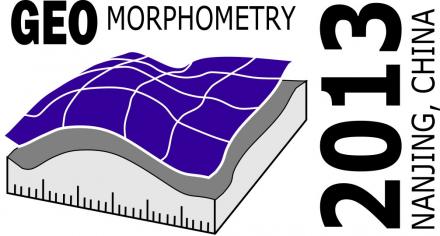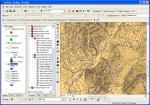Scientific Program
Start: Oct 16 2013 09:30 / End: Oct 20 2013 17:00 Timezone: Asia/Shanghai
DAY 1: Wednesday 16.10.2013
| 0930-1000 | Opening ceremony Word from the local organizers and Chair and Vice-chair of the society |
| 1000-1020 | Group photo and coffee break |
| 1020-1105 | Keynote: Michael Hutchinson New Methods for Incorporating and Analysing Drainage Structure in Digital Elevation Models (K-1) |
| 1105-1150 | Keynote: Chenghu Zhou Extracting geomorphologic features from high resolution DEM (K-2) |
| 1200-1300 | Lunch |
| 1300-1330 | Poster session day 1 |
| Chunmei Wang, Qinke Yang, David Jupp, Lei Wang and Rui Li. Modeling of Topographic Spatial Structures Using Geo-statistical Method (P-1) |
|
| Yi Yan and Fei Xiao. Monitoring topographical changes of island in the outlet of the Dongting Lake from 2000 to 2010 using time series of Landsat images (P-2) |
|
| Fei Xiao, Yi Yan, Qi Feng and Xuan Ban. Characterize the spatial patterns of perennial waterlogged cropland using the micro-geomorphology structure in Jianghan Plain, middle reaches of the Yangtze River (P-3) |
|
| Weiming Cheng. Extraction of loess tableland from digital elevation model and ASTER image (P-4) |
|
| Zhao Mingwei. Extend the Analysis window to improve the Geo-Computation (P-5) |
|
| Shangmin Zhao. Characteristic analysis for typical loess 1 geomorphologic types based on slope spectrum (P-6) |
|
| Ting Zhang, Trevor Page and David Oliver. Effectiveness of Mitigation Measures on Phosphorus Delivery (P-7) |
|
| 1330-1520 | DEM generation methods (session chair: Josef Strobl) |
| Benjamin Bräutigam, Irena Hajnsek and Gerhard Krieger (invited speaker) The TanDEM-X Mission: Earth Observation in 3D (I-1) |
|
| Carlos Grohmann Resampling morphometric data for regional-scale analysis (O-1) |
|
| Niels Anders et al High-Res Digital Surface Modeling using Fixed-Wing UAV-based Photogrammetry (O-2) |
|
| Wan Qiao et al Comparison of several methods for multi-scale DEM generalization in different landform areas (O-3) |
|
| Zeng Fei et al An MPI-CUDA Implementation for The Compression of DEM (O-4) |
|
| Jaroslaw Jasiewicz et al Content-based landscape retrieval using geomorphons (O-5) |
|
| 1520-1540 | Coffee break |
| 1540-1740 | DEM attributes and objects: extraction & mapping I (session chair: Li Fayuan) |
| Lucian Dragut et al Land-surface segmentation to delineate elementary forms from Digital Elevation Models (O-6) |
|
| Fuyuan Liang et al An automated method to extract typical karst landform entities from contour lines on topographic maps (O-7) |
|
| Guruh Samodra, et al Application of supervised landform classification of 9-unit slope model for preliminary rockfall risk analysis in Gunung Kelir Indonesia (O-8) |
|
| Dong Youfu Research on Terrain Significance Index (O-9) |
|
| Liu Kai et al Research on the classification of terrain texture from DEMs based on BP neural network (O-10) |
|
| 1810-2000 | Welcome banquet! |
DAY 2: Thursday 17.10.2013
| 0830-0915 | Keynote: Ian Evans Land surface derivatives (K-3) |
| 0915-10:00 | Keynote: Peter Guth The Giga Revolution in Geomorphometry: Gigabytes of RAM, Gigabyte-Sized Data Sets, and Gigabit Internet Access (K-4) |
| 1000-1020 | Coffee break |
| 1020-1200 | DEM attributes and objects: extraction & mapping II (session chair: Chenghu Zhou) |
| Scott Peckham Mathematical Surfaces for which Specific and Total Contributing Area can be Computed: Testing Contributing Area Algorithms (O-11) |
|
| Liyang Xiong et al Simulating Loess Underlying Bedrock Paleotopographic strata for Landscape Evolution in the Loess Plateau Based on Digital Elevation Models (O-12) |
|
| Shijiang Yan et al Terrain similarity characterizing approach based on two-dimensional continuous wavelet (O-13) |
|
| Wenhui He Research on 3D-Openness in urban area based on Urban Digital Elevation Model (O-14) |
|
| Hongming Zhang et al DEM based Extraction of LS factor: integrate channel networks and convergence flow (O-15) |
|
| 1210-1300 | Lunch |
| 1300-1330 | Poster session day 2 |
| Tian Jian. Point pattern for landform based on SOFM (P-8) |
|
| Kamila Justyna Lis and Tang Goan. Fractal analysis of the Loess Plateau in China (P-9) |
|
| Haijiang Wang and Qinke Yang. Generalizing Resolution-assignable DEM Based on Rational-dilation Wavelet Transform and Sampling Theory (P-10) |
|
| Lei Wang, Yong Qing Long and Fayuan Li. The elevation error of DEMs caused by grid size (P-11) |
|
| Zhang Zhenke, Fu Yuexin, Li Shengfen, Zhang Linghua and F Li. Soil erosion and rill system evolution based on field observation in Kongshan Hill, South-west Jiangsu Province, China (P-12) |
|
| Xu Hong Wang, Zhang Zhe, Fei Li and Xiao Ning Liu. Construction of Remote Sensing Image Information Capacity Model for Evaluation on Land Surface Complexity (P-13) |
|
| Li Xiaoyin. Vegetation Pattern Topographic Differentiation of YaoXian county, Shaanxi province, China (P-14) |
|
| 1430-1500 | Coffee break |
| 1330-1540 | DEM analysis for land-cover, hydrological, soil-landscape and environmental modeling (session chair: Michael Hutchinson) |
| Qinke Yang et al (invited speaker) Study on the Distributed Slope Length for Soil Erosion Prediction at Watershed Scale (I-2) |
|
| Lucian Dragut et al Evaluation of land-surface segmentation as support for soil sampling (O-16) |
|
| Zhen Li et al Development of gully and its controlling factors in the Loess Plateau of China using high spatial resolution imagery (O-17) |
|
| Sheng Li et al From rills to gullies: how do we measure them? (O-18) |
|
| Yi Zhou et al Method for extraction continuous shoulder line in Loess watershed (O-19) |
|
| Dong Chen et al Vegetation mapping using discrete-return and full-waveform airborne LiDAR data (O-20) |
|
| 1540-1600 | Coffee break |
| 1330-1540 | High performance computation and big data in terrain analysis; geo-computing and statistics analysis (session chair: Peter Guth) |
| Alexander Brenning (invited speaker) Leveraging geomorphometric data and statistical computing to gain complementary insights into complex Earth surface processes (I-3) |
|
| Baiping Zhang Mass elevation effect: concept and quantification (O-21) |
|
| Qinke Yang et al Extraction and Analysis of Slope, Slope Length, and LS for National Soil Erosion Inventory in China (O-22) |
|
| Xiaodong Song et al Landscape planning of route-based visibility analysis (O-23) |
|
| Ling Jiang et al Extraction of drainage network from grid terrain datasets using parallel computing (O-24) |
|
| 1800-1830 | Geomorphometry society meeting (elections) |
| 1800-2000 | Conference dinner (outdoor barbeque or similar) |
DAY 3: Friday 18.10.2013
| 0830-1020 | Fundamental problems of geomorphometry I (session chair: Ian Evans) |
| Josef Strobl (invited speaker) DTM Slope – simple measure, or to each his own? (I-4) |
|
| Niculita Mihai et al Floodplain delineation using cluster analysis of geomorphometric variables and class spectral statistics (O-25) |
|
| Kosuke Naruse and Takashi Oguchi Classification and formation environment of glacial valleys based on morphometric analyses (O-26) |
|
| Cheng-Zhi Qin et al A Browser/Server-based Prototype of Heuristic Modelling Environment for Digital Terrain Analysis (O-27) |
|
| Jie Wang et al Modeling hourly solar radiation over rugged terrains, based on DEM (O-28) |
|
| 1020-1040 | Coffee break |
| 1040-1200 | Fundamental problems of geomorphometry II (session chair: Tang Guoan) |
| Zhang Yanli et al Estimating shortwave radiation based on DEM and MODIS atmospheric products in rugged terrain (O-29) |
|
| Hu Ding et al A Near-lossless Digital Watermarking Algorithm of DEM Based on DCT (O-30) |
|
| Biju John et al Use of SRTM Data for a Quick Recognition of the Active Tectonic Signatures (O-31) |
|
| Zhang Zhenke et al Soil erosion and rill system evolution based on field observation in Kongshan Hill, South-west Jiangsu Province, China (O-32) |
|
| 1200-1300 | Lunch |
| 1330-1510 | Fundamental problems of geomorphometry III (session chair: Qiming Zhou) |
| Jing Tang et al Implementation of a multiple flow algorithm into the dynamic ecosystem model LPJ-GUESS (O-33) |
|
| Sheng Jiang Extraction of loess shoulder-line based on object-based image analysis (O-34) |
|
| Shijie Zhu et al Scale-effect of Hypsometric Integral in Loess Plateau (O-35) |
|
| Weiling Guo et al The scale effect analysis of slope length based on DEM multi-scale representation (O-36) |
|
| Sheng Li et al Snow distribution pattern and its influencing factors in a small watershed in Atlantic Canada (O-37) |
|
| 1510-1530 | Coffee break |
| 1600-1700 | Life achievement awards Best paper awards Towards Geomorphometry 2015 |
| 1800-2000 | Dinner and visit to Fuzi temple |
DAY 4: Saturday 19.10.2013:
Workshops from 9:00 to 17:00
| 0900-1200 | Workshop |
| 1200-1300 | Lunch |
| 1300-1500 | Workshop |
| 1500-1515 | Coffee break |
| 1515-1700 | Workshop |
| 1800-2100 | Dinner |
Workshops:
- Peter Guth (US Naval Academy): Free and Open Source Geomorphometry Software
- Jarek Jasiewicz: Watershed modeling with r.stream (GRASS GIS toolbox)
- Scott Peckham: RiverTools 4.0
DAY 5: Sunday 20.10.2013:
Field trip to Zijing mountain and Xuanwu lake (optional) Venue: Xianlin Campus, Nanjing Normal University No.1 Wenyuan Road Nanjing China 32° 6’ 4.9896” N, 118° 55’ 6.312” E


